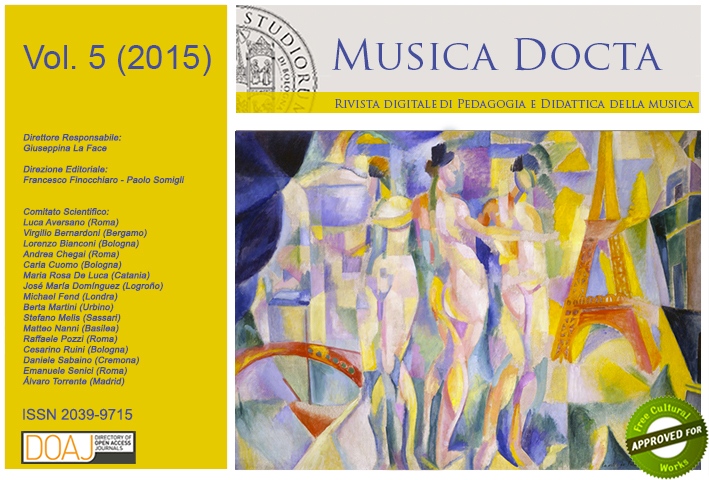Il “soggetto cavato” nella “Missa Hercules Dux Ferrariae” di Josquin des Prez
DOI:
https://doi.org/10.6092/issn.2039-9715/5879Abstract
The article describes a didactic approach to comprehension and production for junior secondary school, focusing on the Kyrie of the Missa Hercules dux Ferrariae by Josquin Des Prez. As is known, Josquin composed this work using the technique of “soggetto cavato” and ‘carved’ the tenor out of a text motto addressed to the dedicatee. The first step in the assignment is listening comprehension, which also includes a brain teasing and an ear training activity. Students are asked to codify the succession of pitches in the tenor in a way that allows to go back to the original motto used by Josquin. This experience puts students back to the center of the interpretive process, and at the same time helps introduce some important notions in Renaissance musical reception, such as that of musica reservata. In the ensuing step, that of production, the rules inferred from the analysis of the Kyrie are put into practice, for the purpose of creating a small two-part polyphonic composition. For students this involves composing a tenor with the “soggetto cavato” technique, converting a short verbal motto of their choice into a short sequence of pitches. Students are then asked to complement the tenor with a second, freer part, modeled after Josquin’s Kyrie. During the whole assignment, in particular during the production stage, students use a music notation software, which gives them greater control over the final result while writing the composition. The author personally supervised these activities in several classes as part of the Music curriculum program for junior secondary schools, collecting the results in the Aulodie blog.Downloads
Published
2015-12-28
How to Cite
Izzo, L. (2015). Il “soggetto cavato” nella “Missa Hercules Dux Ferrariae” di Josquin des Prez. Musica Docta, 5(1), 139–150. https://doi.org/10.6092/issn.2039-9715/5879
Issue
Section
Educational Approaches
License
Copyright (c) 2015 Leo Izzo
The copyrights of all the texts on this journal belong to the respective authors without restrictions.
This journal is licensed under a Creative Commons Attribution Share-Alike 4.0 International License (full legal code).
See also our Open Access Policy.
Metadata
All the metadata of the published material is released in the public domain and may be used by anyone free of charge. This includes references.
Metadata — including references — may be re-used in any medium without prior permission for both not-for-profit and for-profit purposes. We kindly ask users to provide a link to the original metadata record.






